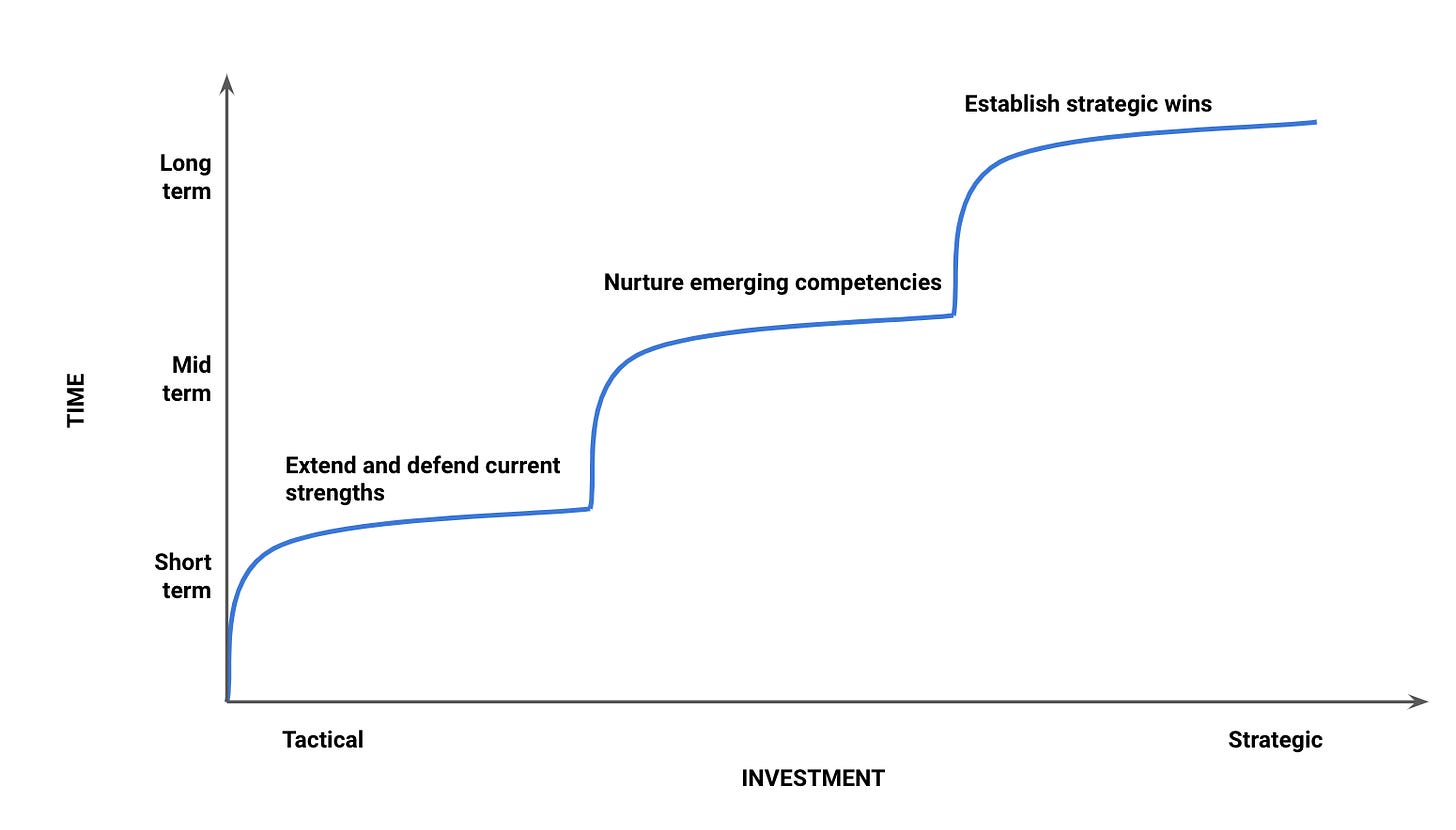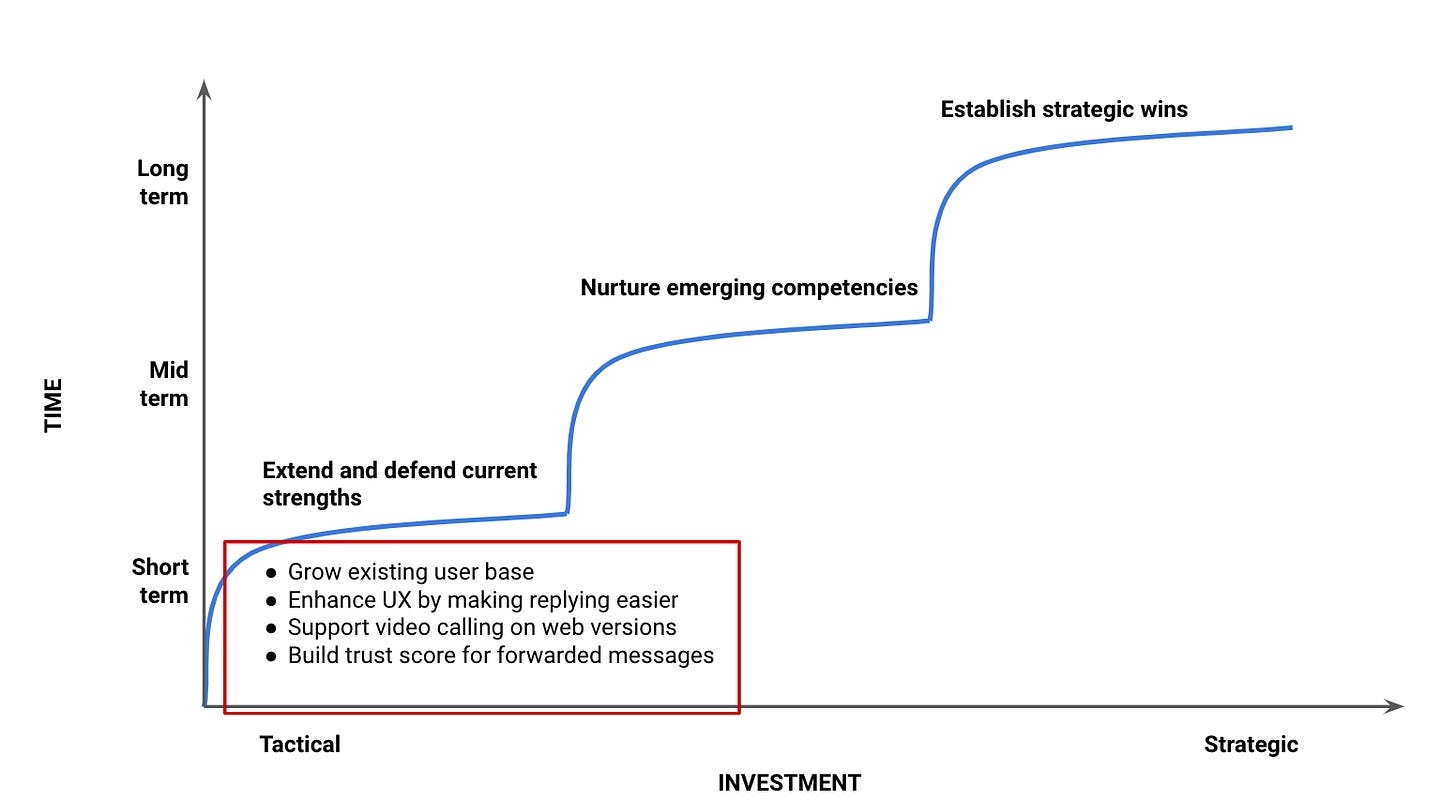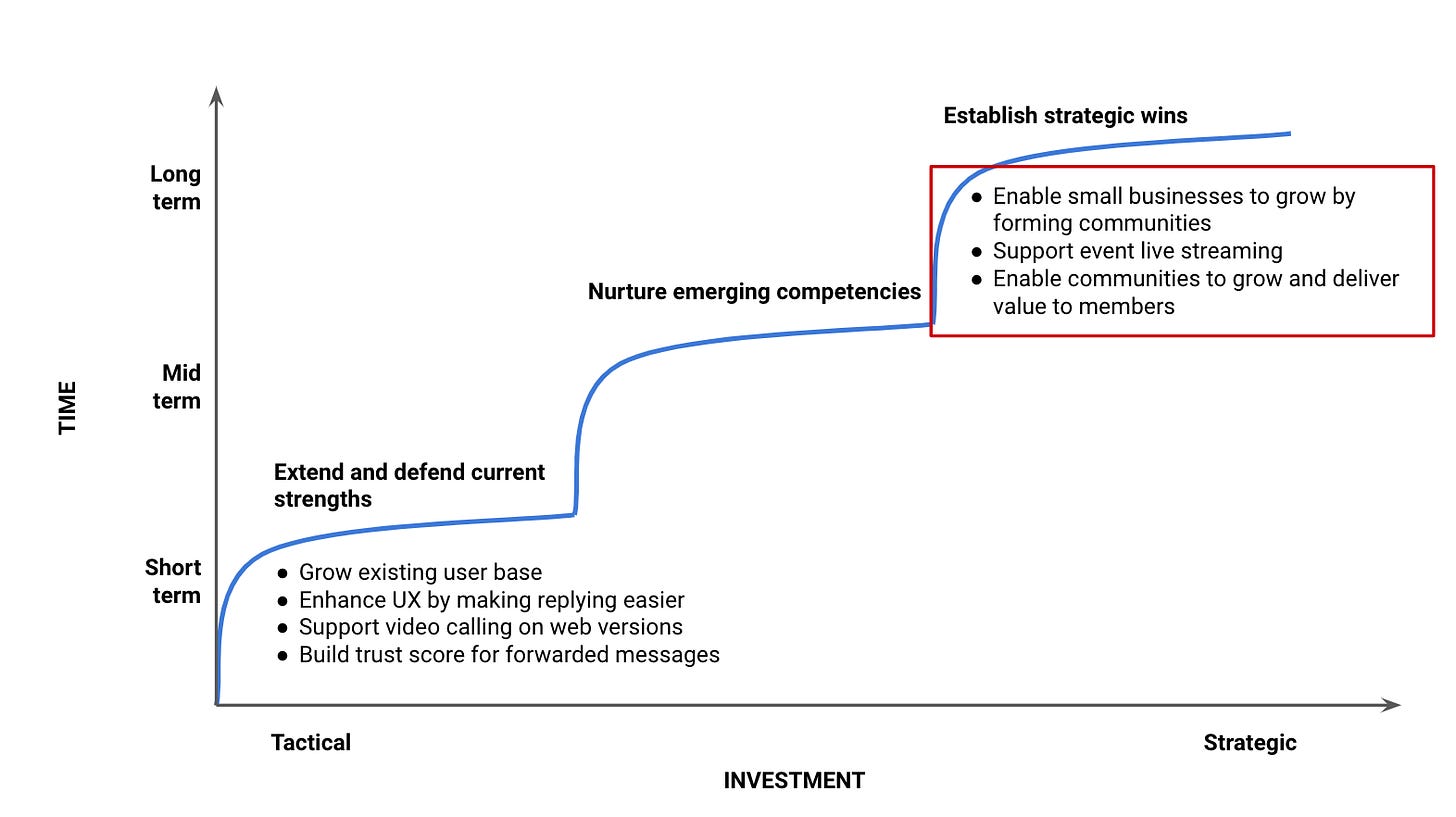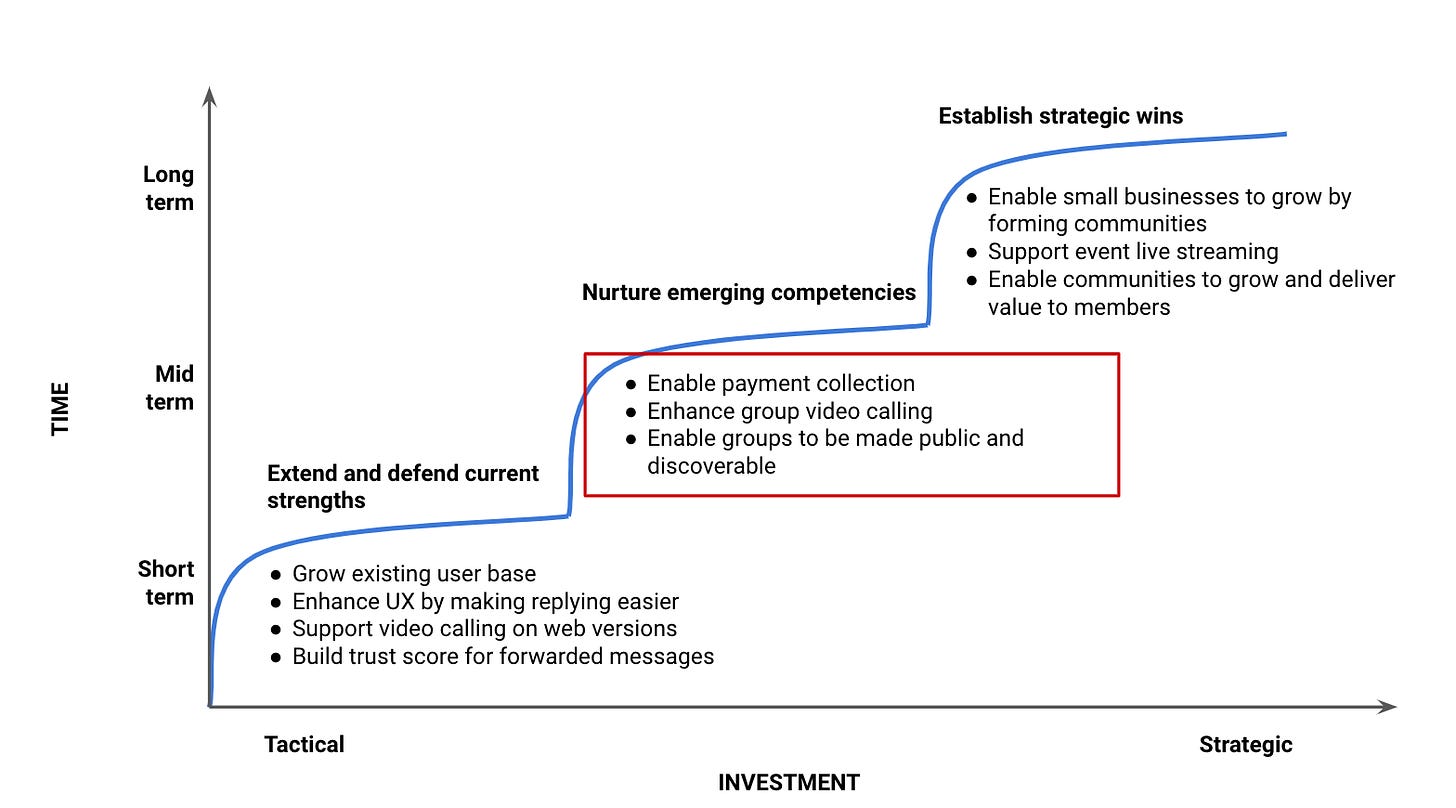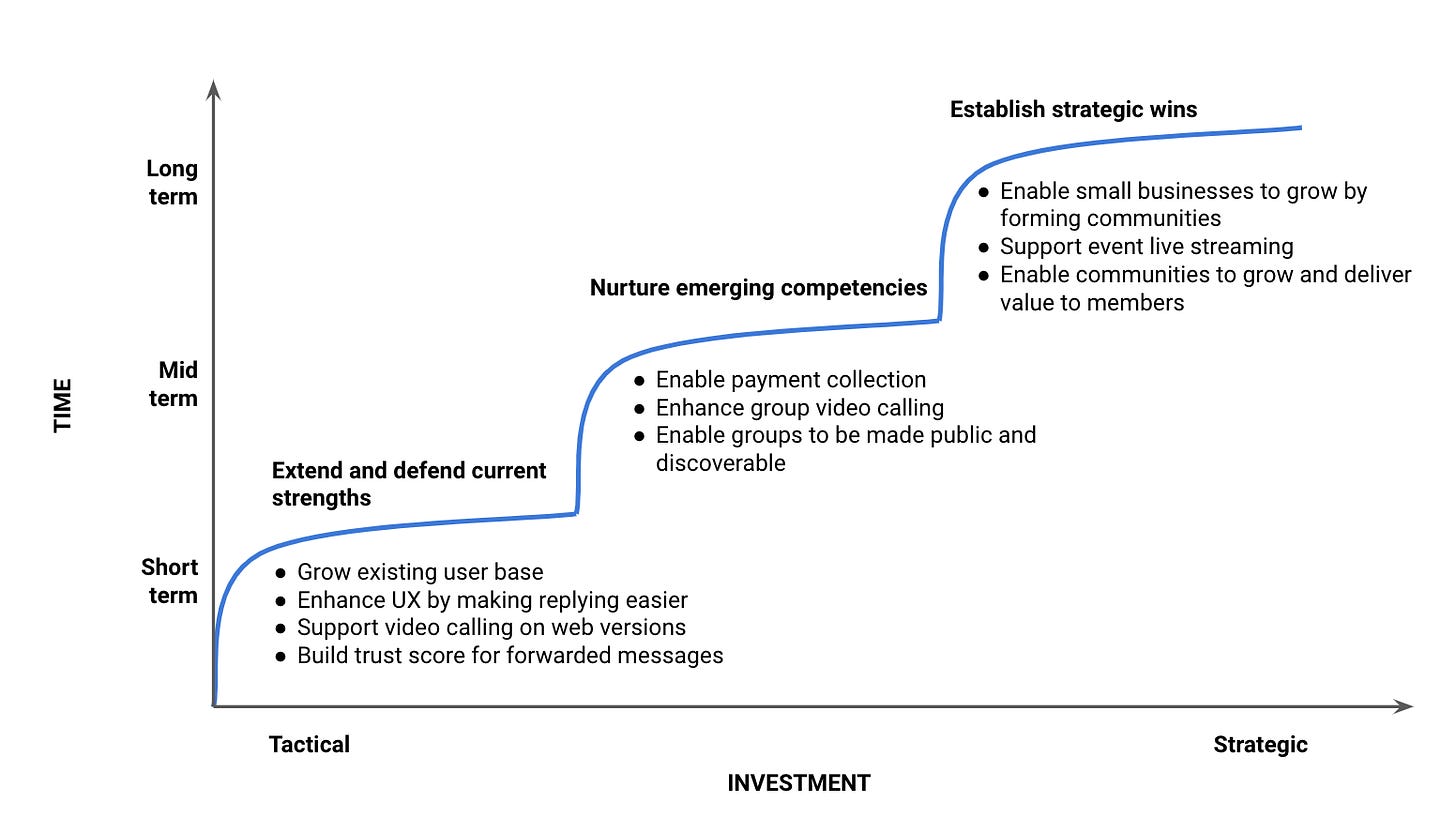The modified 3 horizons framework for Product Strategy
Having a coherent long term product strategy helps product teams prioritise short term wins and impactful long term projects. Formulating this strategy in chaos could be especially difficult - quick wins are tempting until they last, and once the backlog dries up, product teams move on to the next small step. This leads to products never achieving their potential and getting stuck in a locally optimal maxima.
Effective product managers and strategists should have a healthy balance of these 3 in their backlog:
Short term wins
These create customer value today and keep the users happy, business afloat, and teams motivated.Long term strategic achievements
These longer term projects are future facing and have the potential to unlock new product areas for tomorrow.Foundational infrastructure
These projects make for a strong, adaptable product foundation. They enable faster development and quick wins today, and add agility to the product tomorrow.
In order to make my products more sustainable and keep a healthy balance of these in my portfolio, I use a modified version of the Three Horizons of Growth framework. The Three Horizons framework is a hugely popular framework created originally to stimulate innovation within organisations. With just a few modifications, it becomes a solid product strategy framework.
I start with a baseline coordinate system of time and strategic importance, something like this:
The three steps are the three horizons. The first, extend and defend current strengths, depicts all investments I must make in order for the product to survive today. The third, establishing strategic wins, is my vision for where the product will be in the long term. This horizon is ambitious - a kind of wish list/ visionary proposal that I may never get to. The second, nurturing emerging competencies, defines enablers - things that take me from horizon 1 to horizon 3. It’s important to note that the time horizon here is not the time taken to build the feature, but the time horizon in which it is needed for the product.
How to fill in the graph
Start with horizon 1.
This is stuff you already know and see. What you see as your ‘must do’s go here. I’m going to explain this with an example. Let’s imagine I’m building a peer to peer messaging service, something like Telegram or WhatsApp. My goal is to be the best platform for conversations. My horizon 1 would look something like this:
I know my current strengths and my critical features here. My horizon 1 would include things like these:
Grow the existing user base. WhatsApp has a fairly large number of users, but there are still some markets that I would want to win. I would focus on some localisation, referrals, etc for these markets to more firmly establish my product there.
Enhance the UX by making replies easier to improve retention. Assuming my data shows me that users find it difficult to reply to messages, I could add features like drag to reply (WhatsApp did this in 2017).
Support video calling on web. I know that given the locked down state of the world, more and more of us must speak to our friends and loved ones through screens. My competitors are already winning here and I see my users miss having larger screens to make video calls.
Build trust score for forwarded messages. The last decade showed us the power of community forwards, and the damage they can potentially do. For this reason, ensuring that forwarded content is trustworthy makes my list of must dos.
I’ve not really filled in product features or stories here, I’ve filled high level concepts or epics that I want to focus on.
Move to horizon 3.
Horizon 3 is the most ambitious place I want for my product to be in. It shows the true potential of the product. If I’ve accomplished horizon 3, I have built a product that accomplishes everything it set out to do. This is where I want to get to.
For my whatsApp example, I’ve chosen these for my horizon 3:
Enable small businesses to grow by forming communities
Small businesses are the cornerstones to communities. Think of all the local shops in your area that you frequent. They drive prosperity for the community and provide essential services. If I want to build a product that truly focuses on expanding communities, I need to incorporate small businesses. (WhatsApp is reported to actually have started working on this initiative).Support event live streaming
Families and friends sometimes have to miss occasions because they can’t travel to physically be there. Any product that focuses on keeping people together must allow them to witness important events and celebrations.Enabling communities to grow and deliver value to its members.
Data would show that my users use the product for more than just keeping in touch. They use it to network, share common interests, and grow their knowledge.
Do keep in mind that this is a tentative list. I don’t work at WhatsApp and as such have very little insight into their company strategy.
Now do Horizon 2.
Horizon 2 is the bridge. It allows for taking effective and meaningful steps to accomplish horizon 3. In a sense, it allows for step increments which by themselves are meaningful and add value to the customer, thereby mitigating the risk of the unknown and maintaining product foundations while still allowing for innovation. It should thus include step functions that allow for getting to horizon 3. Any item that doesn’t accomplish this moves to horizon 1 if it’s critical, to horizon 3 if it’s essential for the longer term vision, or is discarded if it fits neither.
The horizon 2 for my WhatsApp example looks like this:
Enable payment collection
Payments are a foundational feature of commerce. If I were to allow small businesses to thrive on my platform, payments would be an essential feature. While foundational for horizon 3, it also adds value to my existing user base and solves a pain point. I see the product being used today by friends and family to make small transfers for shared groceries, restaurant bills, etc that one of my user has paid for the group. (WhatsApp launched payments in India in 2020).Enhance group video calling
Supporting event live streaming involves high quality video broadcast to groups. Enhancing group calling builds these capabilities for me. Support for groups over 10, the ability to upgrade/downgrade quality, moderator controls, etc would fall in this bucket. They help me get to my horizon 3 of event live streaming as essential features, and are also useful for my users today who would like to do a group call with family or friends.Enable groups to be made public and discoverable
If I want to build communities of people with common interest, who necessarily don’t share a personal 1:1 relationship, I would need for groups to be discoverable. This will also help existing users by taking the burden of manually adding each member to the group away from the moderator.
By now, my complete 3 horizons framework looks like this:
We use this to create a balanced portfolio of initiatives. In order to get to this prioritised portfolio, I ignore horizon 3, knowing that horizon 2 will enable 3 any way. I make a list of all things I could build for 1 and 2 and estimate their impact potential and time to build. I keep these as separate lists. Then I pick a split of horizon 2 and horizon 1 initiatives. A 60:40 split in time spent for horizon 1 : horizon 2 has worked well for me in the past, but it depends on the product and the growth phase of the company. My final list then is a collection of the highest impact, lowest effort horizon 1 and horizon 2 projects.
I spend 60% of my time working on horizon 1 and keep delivering immediate business value. I spend 40% of my time working on horizon 2, delivering strategic enablers for the future of business.
I revisit and remake this framework often. Again, how often depends on product maturity and the industry you operate in. I’ve updated my framework anywhere between every 6 months and every year. Anything more than a year might be a stretch.
A good thing to remember is that a strategy is a living document. Most companies make 3 year strategies that are revised at least once a year. Far from representing that the company created a bad strategy, the revision reflects an agile and evolving business.
I made a downloadable sheet for this here.
If you found this framework helpful, consider subscribing and sharing it with friends and colleagues!



